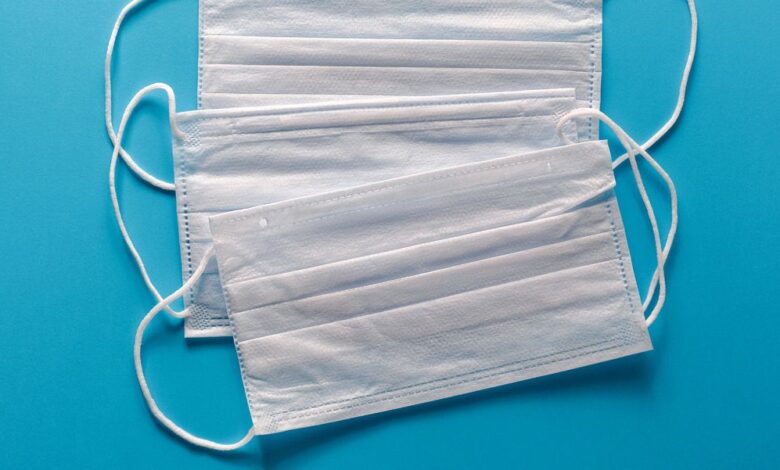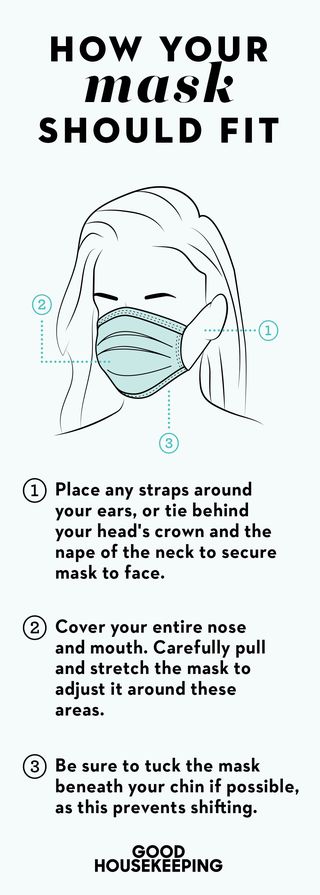How to Wear Two Masks Properly

- Officials at the Centers for Disease Control and Prevention have updated their mask guidelines for Americans to suggest that wearing two masks may boost COVID-19 protection due to improved filtration.
- Adjusting the ear loops on a disposable, medical-grade surgical mask may also offer you a similar amount of protection if you find two layers of masks too restrictive.
- Ultimately, Americans need to improve the fit on a face mask to ensure no air is escaping up towards the eyes or out of the sides of the mask, away from cheeks.
Wearing two masks, or double masking, has been widely debated by infectious disease experts over the last month after Anthony Fauci, M.D., director of the National Institute of Allergies and Infectious Disease, first broached the topic last month. At the time, Dr. Fauci believed that wearing two masks would be “more effective” at preventing aerosols and infectious droplets from impacting others in a public space. Many healthcare providers pushed back at the lack of established data, instead focusing on educating the public on wearing one well-constructed mask correctly (over the nose, under the chin, sealed around your cheeks!) to ensure proper coverage. But officials at the Centers for Disease Control and Prevention (CDC) ended up acknowledging both points as being effective at preventing the spread of COVID-19 in a new update to their mask guidance this week.
CDC officials are now asking the American public to focus on improving the fit of their masks, and if necessary, to indeed double up on masks while in public settings. The updated recommendations are being put into place after new research surfaced this week, published by the CDC, which suggests that a surgical mask worn tightly over the face could dramatically reduce spread while also providing more personal protection for the wearer. The study’s laboratory results suggest that transmission of SARS-CoV-2, the virus that leads to a COVID-19 diagnosis, could be prevented up to 96% of the time if those in public wore tight-fitting surgical masks — or, a surgical mask covered by a cloth-based mask.
Rochelle Walensky, M.D., director of the Centers for Disease Control and Prevention, told the press that the research reinforced the main issue with how many people are wearing masks now, the New York Times reports. It’s well established that wearing any mask can indeed reduce the chance that infectious aerosols or droplets are spread into public air space, all while protecting others around you from inhaling them. But an ill-fitting mask, or one worn incorrectly, can leak air around the edges or seal of a mask, greatly reducing its effectiveness at preventing the spread of COVID-19 overall. It’s especially dire for those who are working in interior spaces that aren’t well-ventilated, or those in essential roles where daily interaction with strangers is a given.
William Schaffner, M.D., the medical director for the National Foundation for Infectious Diseases, explains that CDC’s recommendations for when one or who should be wearing a mask hasn’t changed. Adjusting your mask for a tighter fit, swapping in a surgical mask, or doubling up altogether should be something you consider based on the amount of transmission risk in your area: “The more people in a confined space that you find yourself in, the more you might want to consider wearing two masks, or at minimum wearing one correctly,” he tells Good Housekeeping.
This content is imported from Instagram. You may be able to find the same content in another format, or you may be able to find more information, at their web site.
But should you wear two masks if you’re not in an inside space? And if you do decide to start double masking, which kinds of masks should you use? Below, we’re recapping answers to your top questions about the CDC’s new guidance with the help of a pair of leading infectious disease authorities.
How to wear two masks correctly:
Per updated advice from the CDC, Americans can do two different things to make sure their masks are most effective in a public setting. One option would be to continue to use the cloth masks that many have already purchased but to add a disposable, single-use surgical mask beneath it. The layering here may help to ensure that face gaps are minimized: “The two masks begin to loosely approximate an N95, a respirator,” Dr. Schaffner suggests, adding that the seal is often tighter simply due to layering.
The CDC’s research suggests that only 42% of cough droplets were blocked by those wearing a surgical mask alone — combining the disposable option with a cloth mask blocked 92.5% of infectious particles from a single cough. It also reduced the user’s “cumulative exposure” by 83% for droplets or aerosols in the air around them; that filtration power rises to 96.4% when both of the study’s models wore double masks. But it’s important to note that only the combination of the disposable mask and the cloth-based sewn mask was studied: It’s unclear if two cloth masks, or a surgical mask over a cloth mask, could result in the same amount of protection.
The fit requirements for a surgical mask haven’t changed, and fit should be the utmost concern when wearing any mask, explains Richard Martinello, M.D., the medical director of infection prevention at Yale New Haven Health and its flagship hospital. Whether you’re choosing to layer your masks, or sticking with a single surgical mask, be sure that:
- The mask has a metal nose tab or another feature to ensure a firm seal across your face
- The masks’ ear loops or ties are tightened for a firm (but comfy!) fit across your face. You should not be able to see “puckering” of fabric alongside your cheeks.
- Your mask covers all of your nose, mouth, and sits firmly beneath your chin. Ideally, the mask will be tight across your nose’s bridge, tight along the sides of your cheeks, and anchored by your chin.
- If using a fabric mask, the mask should contain at least three layers of cloth, consisting of tightly-woven fabric choices and one middle layer that functions as a filter.
One thing is certain: Mask users shouldn’t double up on respirators, known as N95s or KN95s, or two disposable surgical masks. Layering surgical masks can actually invalidate the streamlined design for your face, Dr. Martinello explains, and respirators (which are currently largely reserved for medical workers) are meant to undergo a strict fit test. If you only wish to wear disposable surgical masks, the best thing to do is to adjust your mask’s ear loops.
How to properly tighten your masks:
You don’t have to double your masks to improve the filtration and efficacy of a surgical mask — the CDC’s emerging research shows that a simple “knot and tuck” can help you create a better seal on your face. Using this tactic, you’ll ensure that the fit of your disposable mask is conformed to your face by knotting your ear loops together at the edge of the mask itself. Then, you’ll fold and flatten the extra protruding fabric at the mask’s edge, so there’s no gap on your cheeks. Watch the CDC’s commissioned how-to below and follow along with your own mask.
This content is imported from YouTube. You may be able to find the same content in another format, or you may be able to find more information, at their web site.
“I always favor the medical masks, because they’re well designed, as they have a metal band integrated into the mask, helping to ensure it fits well over the nose,” Dr. Martinello says. “It doesn’t always fit everybody the right way, and what some people can find helpful is flipping ear loops 180 degrees around, tightening them up — or even putting a knot into the loop… That mask has good quality filtration material and [knotting] allows it to sit even better than it normally does.”
While many aren’t commercially available just yet, the CDC also shared recommendations for what’s known as a mask fitter or brace — an accessory that helps firmly secure your mask to your face with added ties and a crown loop. This may be an easier solution if tying your surgical mask results in it being too small to appropriately fit beneath your chin and above your nose.
This content is imported from Instagram. You may be able to find the same content in another format, or you may be able to find more information, at their web site.
When should you wear two masks?
There isn’t a mandate to wear two masks, to be clear — currently, 36 states require Americans to wear a single face mask when in public, and there’s a federal mandate in place that requires passengers on public transport or visitors to government buildings to wear a mask.
The CDC’s updated guidelines on double masking make a lot of sense for those who are consistently spending time in confined, poorly ventilated spaces with individuals who are not part of their immediate household. Every person should try to improve their masks’ fit to ensure proper coverage, disposable or not, Dr. Martinello explains, but wearing two masks may not be the best option for all. “If you’re out and about, maybe interacting with people, you should have a well-fitting, high-quality mask on at that point,” he adds.
Dr. Martinello breaks down when wearing both a surgical mask and a cloth-based mask may be appropriate:
- Essential workers who are constantly interacting with the public
- Those who are working in common spaces with coworkers, or congregate spaces
- Anyone who is traveling for an extended period of time on public transport, including air travel
- Anyone entering or receiving treatment in a medical facility
- Anyone who is living with someone who has contracted COVID-19 in your home
In all situations, it’s important to wear masks that are made with multiple layers. You can also make a customized cloth mask with proper coverage at home — follow along with our DIY tutorial here.
Should I wear two masks?
Early promising data from the CDC suggests that wearing tight-fitting masks, including those that are layered with one surgical and one reusable cloth-based outer layer, may further provide more protection against infectious airborne particles. Wearing a properly fitted mask may also reduce the likelihood of anyone unknowingly sick with COVID-19 spreads the virus in public settings.
These findings, however, don’t invalidate the protection and disease prevention that a single properly worn mask provides. Working to reduce the gaps around your nose, cheeks, and chin can be similarly beneficial, experts agree, especially if you are wearing a mask that is constructed correctly. You should always choose a medical-grade surgical mask or a cloth-sewn face mask that is made with tightly woven fabric, and ideally contains three or more layers (as well as filter capabilities in some form).
Both Dr. Schaffner and Dr. Martinello agree: Wearing two masks may be too restrictive for some, especially for those who are already short of breath. If double masks are causing you to gasp and breathe erratically, they may work counterintuitively and cause airflow to come in from the sides of your face, and not through the mask as it’s intended. Double masking may be a trial and error for some. If you find yourself desperate for air and needing to frequently remove these masks in the first place, it’s better to focus on improving the fit of a surgical mask or the fit of a well-constructed cloth option alone.
This content is created and maintained by a third party, and imported onto this page to help users provide their email addresses. You may be able to find more information about this and similar content at piano.io
Source link




